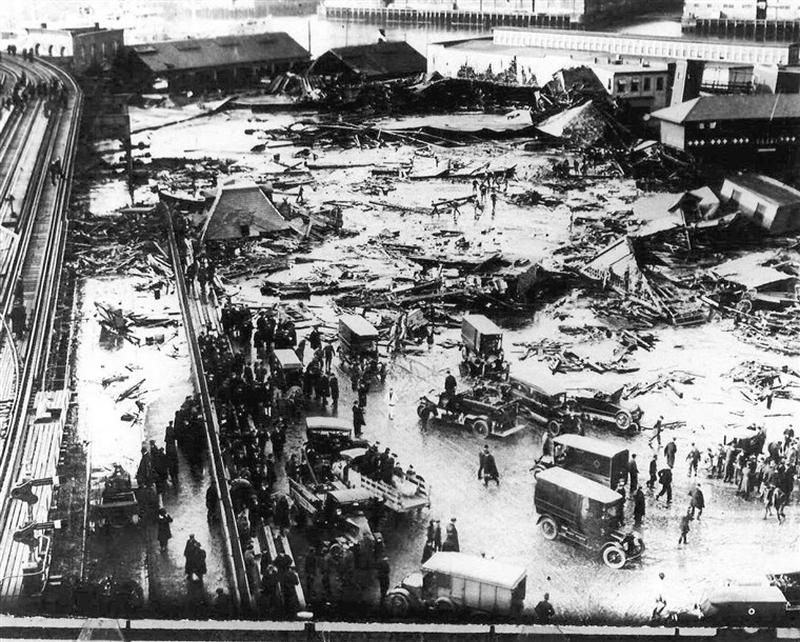The Great Molasses Flood Sounds Like A Joke, But It Killed 21 Bostonians
By | January 13, 2020
Science and poor planning caused the flood
On January 15, 1919, the Boston area found itself in a sticky situation. That afternoon, a tank full of molasses exploded while traveling through Boston, sending 2.3 million gallons of the sickeningly sweet stuff rushing through the streets of Beantown. As ridiculous as this tragedy sounds, the torrent of molasses was deadly: 21 people died, 150 more were injured, and the mess took months to clean. Dubbed "The Boston Molassacre," the accident affected the entire city, and according to local legend, the smell of molasses hung over Boston for years. Who knew that syrup could be so terrifying?

Whenever we read about a tanker trunk loosing its product, it's usually because the vehicle has overturned, but in the case of the Boston molasses flood, it was a combination of poor planning and simple science. The truck belonged to the Purity Distilling Company, which used the vehicles to transport molasses to its ethanol plant, where it was stored for transfer at a later date. Purity tankers rose up to 50 ft. tall and held 2.3 million gallons.
At 40 degrees Fahrenheit, January 15 was a warm day for winter on the east coast. After weeks of freezing weather, it's likely that the cold molasses expanded as a result of the sudden warmth. The tank burst open around 12:30 P.M. with such force that witnesses reported what felt like an earthquake rumbling through the city. The closest bystanders said that they heard noises like a machine gun firing as the tank's rivets popped out of their holes.
The tanker was a ticking time bomb

Decades after the explosion, multiple inquiries were made into the safety of the tanker, and it was found that the container was nowhere near as secure as it should have been. One investigation showed that Arthur Jell, USIA's treasurer, failed to perform even the most basic safety tests. It wasn't filled with water to check for leaks, and multiple groans were heard coming from the tank that were completely ignored. In 2014, a modern investigation was performed, and scientists discovered that the walls were half as thick as they should have been and far too brittle to hold that much liquid.
The first and only tidal wave of sugar

When the molasses burst from the tanker, it came out in a 25-ft. wave that sped through the city at 35 miles per hour. The wave was strong enough to tip a streetcar from its tracks and even knock a few buildings off their foundations, and the blocks closest to the explosion were flooded with up to 3 feet of molasses. At the time, the Boston Globe reported:
Molasses, waist deep, covered the street and swirled and bubbled about the wreckage ... Here and there struggled a form—whether it was animal or human being was impossible to tell. Only an upheaval, a thrashing about in the sticky mass, showed where any life was ... Horses died like so many flies on sticky fly-paper. The more they struggled, the deeper in the mess they were ensnared. Human beings—men and women—suffered likewise.
The wave was wildly destructive

According to the Boston Globe, people who were closest to the explosion were picked up by the wave just like they would be in the ocean and pushed away like so much debris. A truck was thrown into Boston Harbor, windows were smashed out, and the surrounding blocks were turned to rubble. The smell of brown sugar filled the air as bystanders found themselves stuck in the viscous flood. Of the 21 people who perished in the incident, many of them drowned in the sticky wave. On top of the people who were killed or injured, dogs and horses also got caught in the melee. A 1983 article for Smithsonian Magazine describes the events:
Anthony di Stasio, walking homeward with his sisters from the Michelangelo School, was picked up by the wave and carried, tumbling on its crest, almost as though he were surfing. Then he grounded and the molasses rolled him like a pebble as the wave diminished. He heard his mother call his name and couldn't answer, his throat was so clogged with the smothering goo. He passed out, then opened his eyes to find three of his four sisters staring at him.
Victims continued to pop up for months

Hundreds of responders rushed to the scene, including cadets from the U.S.S. Nantucket who were in the middle of training, but there was no way to save everyone caught in the sugar storm. Chaos broke out after the first crash of molasses, and as people attempted to free themselves from the tacky mess, they became stuck and unable to move. A triage center was set up in a building close to ground zero, but no one was prepared for a disaster of this magnitude. Some victims were so caked in molasses that it was impossible to recognize them, while others were washed into Boston Harbor. Their bodies went unrecovered for months.
Cleanup took months but the smell lasted years

Cleanup crews faced the mind-boggling task of removing the dried syrup that had caked the streets in such a thick layer that bodies were still encased in its gummy depths. Hundreds of people contributed to the city's repair, but the further the campaign spread out, the city became harder to clean as members of the crews dragged molasses into their cars, onto side streets, and into their homes when they left the job site. Boston was covered in the sweet stuff for months, a nasty reminder of the explosion that brought so much destruction to one of America's oldest towns.

